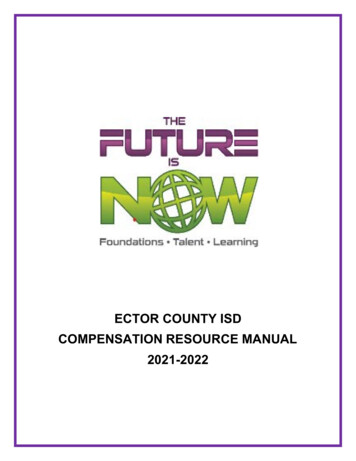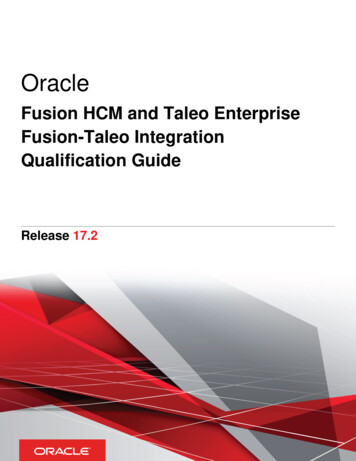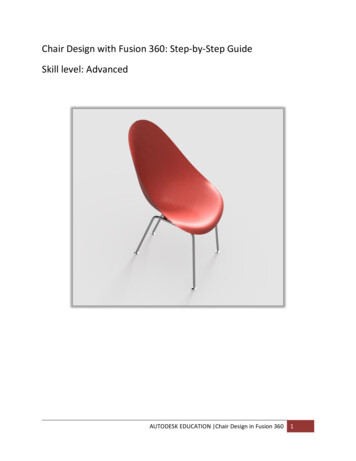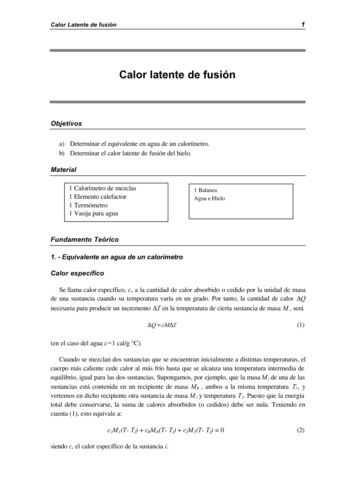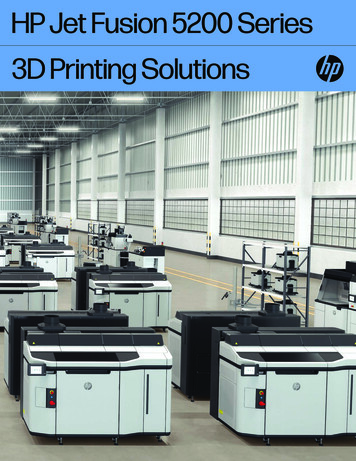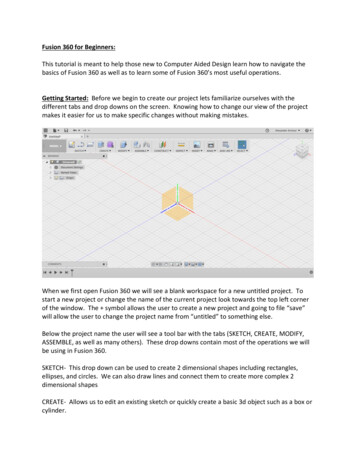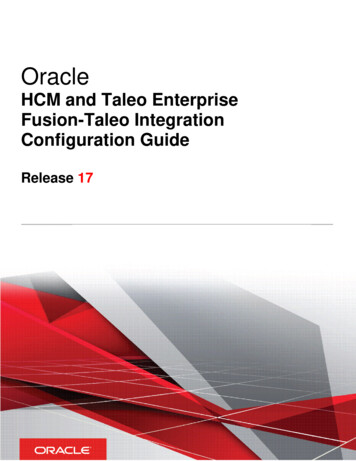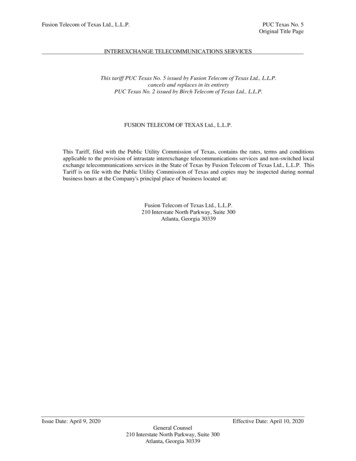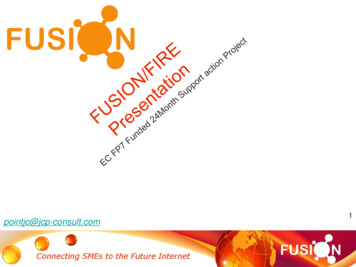
Transcription
Jean-Charles PointFUSION Coordinatorpointjc@jcp-consult.com1
Presentation Summary FIRE and FUSIONFUSION introductionSME involvement and use casesFUSION support and open calls2
Positionning FIRE and FUSION FIRE: Future internet research and experimentation: tries to fill the gapbetween visionnary research and large scale experimentation including: Experimentally driven research Design and experimentation of new networking and servicearchitectureFIRE gathers and federates a set of experimental facilities on these 2aspects3
FIRE Roadmap Current scheme: projects proposals on different ICT calls(obj. 1.7) prolonged by H2020 Open calls to include additional experimentations(funded by EC via projects) Long term objective to provide perennial experimentalfacilities (with academic/ industry driven objectives)
Projects and areas in FIRE
Presentation Summary FIRE and FUSIONFUSION introductionSME situation in experimental facilitiesFUSION support and open calls6
FUSION Introduction Acronym: FUSIONFull Title: Cost Effective Integration and Fusion of SME Communities withNetwork Research Tools and FacilitiesType of Funding Scheme: Support Action (SA)Duration: 24 MonthsWork Program Topic: FP7-ICT-2011-8 Objective: ICT-2011.1.6 (e) Call 8 CONSORTIUMPartner NameCountryJCP-CONSULT SASFranceMARTEL GMBHSwitzerlandREDZINC SERVICES LIMITEDIrelandQuartzSpark LimitedIreland7
FUSION Project ObjectivesIn short: inform SMEs, collect feedback on SMEs requirements andprovide recommendations to match experimental facilities offers toSMEs requirement: Overall objective:– To focus specifically on involving SMEs more in the FIRE facilities Key sub-objectives:– Educate SMEs and SME clusters about the FIRE networking capabilities– Educate the FIRE testbeds about the user requirements from SMEs incertain industry verticals, focusing especially on the networkrequirements aspects (security, confidentiality, guaranteed capacityreserved, segregation of capacity, process of putting tools together infederation) Inventory of testbeds, gap analysis and roadmap8
9
Presentation Summary FIRE and FUSIONFUSION introductionSME involvement and use casesFUSION support and open calls10
Concretly Your company has a software/application/product thatneeds to run specific trials. You identify (with the help of FUSION) a testbed ortestbed federation* that could offer you the requiredservices (usually for FREE). Fusion introduces you and assures correct pick-up. If there is an open-call you might get financial support. You collaborate on European level and will haveinternational expertise available. You integrate the FIRE environment and probablybenefit from further collaborations with support from theEC.11
*: One Example: Fed4FIREFed4FIRE is a one-stop access point to FIRE facilities (testbedsthat each offer facilities to a specific Future Internet community)Advantages to experimenters: Easier to find the right resources to translate their ideas into actualexperiments, Easier to gain access to different nodes on different testbeds, Easier to use the same experimenter tools across the differenttestbedsThe federation is also useful from the infrastructure providers’point of view, since they can reuse common tools developed bythe federation, they can reach a larger community of possibleexperimenters through the federation12
OVERVIEW OF THE TESTBEDS CURRENTLY BELONGING TOFed4FIRE13
Available testbeds in Fed4FIREWired: Virtual Wall (iMinds) PlanetLab Europe (UPMC) OFELIA islands of UBristol and of i2CAT BonFIRE (EPCC island and INRIA island) Koren (NIA)Wireless w-iLab.t (iMinds) NITOS (UTH) Netmode (NTUA) SmartSantander (UC) FuSeCo (FOKUS) Norbit (NICTA)14
2 Examples of use cases Use case 1 is an example of commercialcompany realising the interest of FIRE Use case 2 is more classical technology startupproducing cloud gaming platform
Utilization of Fed4FIRE infrastructure for performingexperiments for designing future-proof architecture of multichannel marketing platformWHAT? Multi-channel marketing platform: multicast delivery of different digitalmessages (SMS, e-mails, QR-codes, messages inside social networks etc.) Used for communication with consumers about business transactions:appointment and payment reminders, discount campaigns, use coupons, etc.WHY? Current systems suffer from peak loads (e.g. during seasonalcampaigns) Development of smartphones will impose great challenge to systemthroughput in near future Difficulties in rapid deployments “on demand”HOW? Via usage of Fed4FIRE facilities for: Determination of optimal geographical nodes distribution; Performing of scalability/QoE tests; Testing of novel approaches for messaging platform: Cloud-based architecture Novel database technologies Loadbalancing mechanisms Message engines replication
3-steps approach, 3 Fed4FIRE testbeds:1. Definition of optimal geographical distribution of nodes and measuring ofaccompanying parameters: At PlanetLab Europe: installation of instance of multi-channel marketingplatform at center of Europe (Rennes), North of Europe (Stockholm) and South ofEurope (Athens) Performing of measurement of actual network characteristics and relevantbottlenecks (useless packets, checksum errors, lost packets etc.)2. Identifying of maximum scalability of the current platform and measuringof accompanying QoS deteriorations: At Virtual Wall: setup of the architecture of the platform (including severalhundred clients) with pre-configured network layer parameters (previouslydefined on the PlanetLab Europe at step#1) Measurement of load limit where clients QoS will be at the minimumacceptable level3. Implementation and testing of the novel algorithms for dynamicallyranging highly scalable cloud-based platform At BonFIRE: setting up of architecture and testing of implemented solutions: Splitted READ/WRITE access to databasesDatabase/API loadbalancing (between BonFIRE cloud nodes)Message engines replication
Swiich: making videogamesaccessible from the cloud on allscreens
Swiich Cloud Gaming tests toperform Intelligent and flexible distribution of 3D applications, services andcontent to users in a variety of network environments Network constraints for real time interaction:– 720p interactive image – 30 FPS – on wired network on 5Mbps link– 480p interactive image – 25 FPS – on 4G networks on 2Mbps link Optimal server provisioning, depending on user-geography andresource availability (datacenter, program to execute, device,network conditions ) Scalability at the server level for:– Adaptive transmission protocol (feedback loop and forward loop)depending on network bandwidth, latency, packet loss to dynamicallyadjust image definition– Real-time sound transfer without audible distortionPlatforms: virtual wall, bonfire, planetlab
Presentation summary FIRE and FUSIONFUSION introductionSME invovlment and use casesFUSION support and open calls20
Open call process Lighter but identical to EC calls:– Call published with deadline– Proposals to be submitted in format identical toother EC proposals– EC formal evaluation– Proposer added as partner (or subcontractor iflow fee) to the project Pro and cons:– Some administration needed (but supportpossible)– Access to other partners and EC projects
Open Calls (1/3) CREW– Testbed focused on advanced spectrum sensing, cognitive radio andcognitive networking strategies for horizontal and vertical spectrumsharing in licensed and unlicensed bands.– 3rd Open Call for small experiments, which offer SMEs extensive supportby the CREW consortium rather than funding.– Deadline for the call is October 2nd, 2013.– (Fusion webinar Sept 17th, 14h30 CET)
Open Calls (2/3) CONFINE– A facility built on the federation of existing community IP networksconstituted by more than 20,000 nodes and 20,000 Km of links.– These community networks incorporate a large and wide variety ofcommodity wireless and optical links, heterogeneous nodes, differentrouting protocols, applications and a large number of end-users,following an innovative model of self-provisioning using unlicensed andpublic spectrum.– The project develops an unified access to an open testbed with tools thatallow researchers to deploy, run, monitor and experiment with services,protocols and applications on real-world community IP networks– Deadline: October 19th, 2013.– (Fusion webinar: Sept 24th, 14h30 CET)
Upcoming events Meetings & Presentations: 1 FIRE Concertation: October 2013PPP presentation days in Brussels: Sept 25th, 2013ICT 2013 event, Vilnius: Nov 7th,8th, 2013London- Uk Roadshow: December 2013 If you have an event and you want us to be present, please contact us! Webinars: Cognitive Radio webinar (CREW project): Tuesday sept 17th, 2:30pm CET(link available on the website) Connected Communities webinar (CONFINE project): Tuesday sept 24th,2:30pm FI-PPP call, webinar Oct 15th, 2:30 pm. All info available on our website: www.sme4fire.eu25
Needs from SMEs Engagement and support from the testbed owners Expertise on the subject matter as well as the testing facilities and how to bestprogress their product Efficiency in terms of their time – easy to access facilities and set up tests Free (or with funding), but without a lot of paperwork and bureaucracy A clear list of testbed offerings both technical and business from each testbed More ?26
FUSION needs from SMEs Contact us (info@sme4fire.eu) to have a call or workshop to understand yourtesting needs Tell us what your testing requirements are Tell us what products and services you are trying to build and get validation for Tell us when is your next cluster event so we can come and host a workshop ordiscuss the testbed facilities with you27
Thanks!!!www.sme4fire.euinfo@sme4fire.eu
Open Calls (3/3) FI-PPP– Expension of Use-cases & extending the technology foundation.– Deadline: Dec 10th, 2013.– This 3rd call is more cluster oriented, however the accepted projects(around 20 selected) must launch Open calls/ Calls for proposals,starting June-Sept 2014 to integrate FI-PP projects. H2020– Follow-up of FP7.– First calls published December 2013, Deadlines: March/April 2014
Virtual wallEmulation environment that consists of 100 nodes (dual processor, dual core servers)interconnected via a non-blocking 1.5 Tb/s Ethernet switch, and a display wall (20 monitors)for experiment visualization. Each server is connected with 4 or 6 gigabit Ethernet links tothe switch. The experimental setup is configurable through Emulab, allowing to create anynetwork topology between the nodes, through VLANs on the switch. On each of these links,impairments (delay, packet loss, bandwidth limitations) can be configured. The Virtual Wallnodes can be assigned different functionalities ranging from terminal, server, network nodeto impairment node. Being an Emulab testbed at its core, the Virtual Wall hs displayed ahigh level of flexibility, since it is also applied in the context of OpenFlow experimentation inits role of an OFELIA island, and in the context of cloud experimentation in its role of aBonFIRE island.Status: Existing testbed, expected to be available through the federation at the end of thefirst development cycle of the project (Feb. 2014)The testbed will remain available until the end of the project (Sep. 2016)Features: Create any desired network topology30Benefits: Scale, control
Planet labPLE is the European arm of the global PlanetLab system, the world’s largestresearch networking facility, which gives experimenters access to Internetconnected Linux virtual machines on over 1000 networked servers located inthe United States, Europe, Asia, and elsewhere. In all cases these servers areconnected directly to the public Internet, without any firewall or proxy server inbetween. Researchers use PLE for experiments on overlays, distributedsystems, peer-to-peer systems, content distribution networks, networksecurity, and network measurements, among many other topics.Status: Existing testbed, expected to be available through the federation atthe end of the first development cycle of the project (Feb. 2014)The testbed will remain available until the end of the project (Sep. 2016)Features: Inclusion of machines connected directly to the Internet and spreadacross a large geographical areaBenefits: Scale, real-life aspect31
BonFIRE (EPCC island and INRIA island):The focus of BonFIRE experiments is on cloud computing experiments. BonFIRE consists ofsix different BonFIRE testbeds, of which three are represented through BonFIRE in Fed4FIRE:EPCC and INRIA. In this context, these testbeds are only accessible through the BonFIREService APIs, not directly. BonFIRE has been designed around four principles: Observability,Control, Advanced Cloud Features and Ease of Use. In terms of provided hardware, the twoislands are characterized as follows: At the EPCC island, two physical hosts provide 4 AMD Opteron 2.3GHz processors each,with a total 96 cores and 256GB of memory. A separate front-end node offers 24TB of disk,available to all cores through NFS. In-depth monitoring information at VM and hypervisor levelis made available to the experimenters through the Zabbix framework. INRIA’s contribution is composed of a permanent set of resources shared between users, andof on-request resources taken from the local Grid’5000 node when at the request of BonFIREusers. The permanent resources are provided by 4 physical hosts provide 2 Intel hexa coremachines. A separate front-end node offers 3.82TB of disk, available to all cores through NFS.In-depth monitoring information at VM and hypervisor level is made available to theexperimenters through the Zabbix framework.32
KorenKoren is a high-speed research network interconnecting 6 POPs in Korea (with support for bandwidth ondemand), and also connecting to other international research networks. At the POPs, there are someOpenFlow switches and DCN switches, and servers that can host virtual machines. An experiment looksas follows: VMs are created that act as data sources and/or sinks in the experiment. These are physically deployedat one or more POPs. At every POP of interest, the experimenter can reserve several ports of the OpenFlow and DCNswitches. To control how traffic will be forwarded over these ports, the experimenter deploys a new VM onwhich he installs a controller such as NOX. If the experiment makes use of several POPs, the experimenter can reserve dedicated bandwidthbetween them. Because of the high-speed link to Geant, it is also possible to combine this Koren part ofthe experiment with other components belonging to the Fed4FIRE federation. But bandwidth cannot beguaranteed outside of the Koren Network.Status: Existing testbeds, expected to be available through the federation at the end of the firstdevelopment cycle of the project (Feb. 2014)The testbed will remain available until the end of the project (Sep. 2016)Features: OpenFlow switching, opticalBenefits: Unique type of provided resources33
w-iLab.tThis testbed is intended for Wi-Fi and sensor networking experimentation. It is located in Zwijnaarde, adistrict of Ghent, and belongs to iMinds. It can be found in an unmanned utility room (size: 66m x 22.5m).There is practically no external radio interference in this deployment. At this location, hardware is hosted at60 spots. Every spot is equipped with: 1 embedded PC with 2 Wi-Fi a/b/g/n interfaces and 1 IEEE 802.15.1(Bluetooth) interface; a custom iMinds-Rmoni sensor node with an IEEE 802.15.4 interface; an“environment emulator” board, enabling unique features of the testbed including the triggering of repeatabledigital or analog I/O events at the sensor nodes, real-time monitoring of the power consumption, andbattery capacity emulation. There are two additional possibilities in the Zwijnaarde deployment: a number ofcognitive radio platforms (including USRPs) as well as specialized spectrum scanning engines areavailable at this location. This enables state-of-the art research in the field of cognitive radio and cognitivenetworking. Besides, a deployment with 20 mobile robots is planned for 2013. This will allow experiments tobe scheduled that include up to 20 mobile nodes (similar to the 60 fixed nodes) to be operated in theenvironment.Status: Existing testbed, expected to be available through the federation at the end of the first developmentcycle of the project (Feb. 2014)The testbed will remain available until the end of the project (Sep. 2016)Features: Wi-Fi testbed, indoor deployment, mobile nodesBenefits: Minimum wireless interference, controlled mobility of mobile nodes34
NITOSThe NITOS testbed is a Wi-Fi testbed of the University of Thessaly, Volos, Greece. It consists of50 nodes installed in- and outdoors in an office environment, and 50 additional nodes are currentlybeing installed in an indoor shielded environment (basement). Three different hardware types areinstalled, with different performance characteristics and 802.11 technologies.–––30 nodes similar to the Norbit nodes: 1 GHz VIA C3 CPU, 2 IEEE 802.11a/b/g interfaces20 so-called Commell nodes: Intel Core 2 Duo P8400 2.26 GHz, 2 IEEE 802.11a/b/g interfaces. 16 ofthese nodes are deployed in a grid, the 4 others are attached with GNU Radio boards and supportMIMO features.50 so-called Icarus nodes: Intel Core i7-2600, 1 IEEE 802.11 a/b/g interface, 1 IEEE 802.11 a/b/g/ninterface. These are the nodes that are being installed in the shielded environment.On each node, one of the two Ethernet interfaces is connected to an OpenFlow switch. This way,the testbed can also be used for OpenFlow experimentation next to the typical Wi-Fi experiments.Status: Existing testbed, expected to be available through the federation at the end of the firstdevelopment cycle of the project (Feb. 2014)The testbed will remain available until the end of the project (Sep. 2016)Features: Wi-Fi testbed, Real-life and shielded environment, OpenFlow supportBenefits: Combination of different wireless environments, scale35
BonFIRE (EPCC island and INRIA island): The focus of BonFIRE experiments is on cloud computing experiments. BonFIRE consists of six different BonFIRE testbeds, of which three are represented through BonFIRE in Fed4FIRE: EPCC and INRIA. In this context, these testbeds are only accessible through the BonFIRE Service APIs, not directly.

